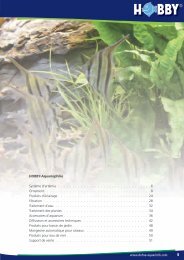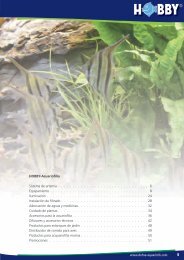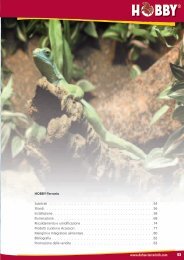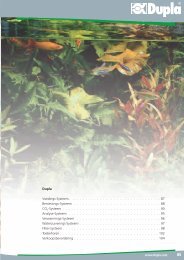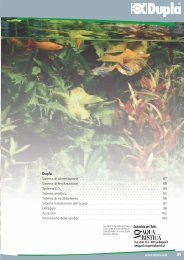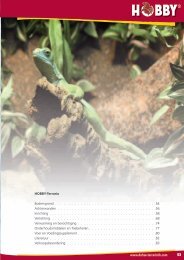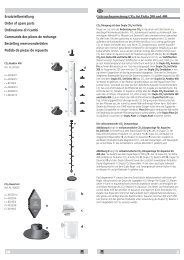Dupla RO 190 Dispositivo de ósmosis inversa Dupla RO 190 ...
Dupla RO 190 Dispositivo de ósmosis inversa Dupla RO 190 ...
Dupla RO 190 Dispositivo de ósmosis inversa Dupla RO 190 ...
You also want an ePaper? Increase the reach of your titles
YUMPU automatically turns print PDFs into web optimized ePapers that Google loves.
Gebruikshandleiding<br />
<strong>Dupla</strong> <strong>RO</strong> <strong>190</strong> omgekeer<strong>de</strong> osmose-installatie<br />
<strong>Dupla</strong> omgekeer<strong>de</strong> osmose-installaties zorgen voor een optimaal uitgangswater voor zee-en zoetwater aquaria.<br />
Vaak kunnen veel waterproblemen pas wor<strong>de</strong>n opgelost door het gebruik van osmosewater. Omgekeer<strong>de</strong><br />
osmose-installaties (Reverse Osmosis) werken op het principe van <strong>de</strong> fysische filtering. In tegenstelling tot <strong>de</strong><br />
ionenwisselaar, die hardheidveroorzaken<strong>de</strong> ionen (zoals calcium) door an<strong>de</strong>re, niet hardheidveroorzaken<strong>de</strong><br />
ionen (zoals natrium) vervangt, wor<strong>de</strong>n bij <strong>de</strong> omgekeer<strong>de</strong> osmose-installatie scha<strong>de</strong>lijke stoffen (bijvoorbeeld<br />
silicaat, nitraat) en hardheidveroorzakers fysisch uit het water verwij<strong>de</strong>rt. Het water loopt in <strong>de</strong> omgekeer<strong>de</strong><br />
osmose-installatie door <strong>de</strong> in huishou<strong>de</strong>ns aanwezige normale waterdruk van 2-6 bar door een beperkt doorlaatbare<br />
(semi-permeabel) membraan. De in het water opgeloste bestand<strong>de</strong>len (scha<strong>de</strong>lijke stoffen, zouten<br />
hardheidveroorzakers) kunnen niet langs <strong>de</strong> kleine roosterstructuur van het membraan en blijven achter in het<br />
afvalwater. Dit afvalwater wordt als concentraat geloosd en kan veilig als poets-, giet- of gebruikswater wor<strong>de</strong>n<br />
gebruikt. De omgekeer<strong>de</strong> osmose-installaties van <strong>Dupla</strong> hebben een opvangpercentage van 95-98 % van<br />
alle scha<strong>de</strong>lijke stoffen uit het leidingwater.<br />
Tip: Door het aansluiten van een <strong>Dupla</strong> puur water-filter (optioneel accessoire) kunnen zelfs minimale resten<br />
van silicaten en nitraten volledig wor<strong>de</strong>n verwij<strong>de</strong>rd.<br />
Membraanopbouw in omgekeer<strong>de</strong> osmose-installaties:<br />
Permeaat<br />
Concentraat<br />
2<br />
1<br />
3<br />
Verzamelbuis zuiver water<br />
12<br />
13<br />
10<br />
Een merk van<br />
Dohse Aquaristik KG<br />
Ingang ongezuiverd<br />
water<br />
4 5 6<br />
11<br />
Membranen<br />
Verzamellaag zuiver water<br />
Doorstroming ongezuiverd water<br />
Buitenlaag<br />
7<br />
Kenmerken <strong>Dupla</strong> <strong>RO</strong> <strong>190</strong>:<br />
• capaciteit: tot <strong>190</strong> liter<br />
permeaat / dag<br />
• inclusief koolstoffilter<br />
• inclusief 5 µm sediment filter<br />
• inclusief begrenzer voor <strong>de</strong><br />
doorstroom<br />
• gemonteerd op een bord<br />
• inclusief 3/4 inch aansluiting<br />
voor waterleiding<br />
Leveromvang <strong>Dupla</strong> <strong>RO</strong> <strong>190</strong>:<br />
• omgekeer<strong>de</strong> osmoseinstallatie,<br />
gemmonteerd op<br />
een bord (10)<br />
• aansluitingen met 3/4 inch<br />
schroefdraad<br />
• bevestigingsschroeven (9)<br />
• gebruiksaanwijzing<br />
• garantiekaart<br />
Inbedrijfstelling:<br />
De <strong>Dupla</strong> <strong>190</strong> <strong>RO</strong> omgekeer<strong>de</strong> osmose-installatie wordt compleet geleverd met alle benodig<strong>de</strong> on<strong>de</strong>r<strong>de</strong>len<br />
voor <strong>de</strong> werking. De meegelever<strong>de</strong> pluggen en schroeven dienen gebruikt te wor<strong>de</strong>n om uw installatie op een<br />
geschikte plaats in <strong>de</strong> buurt van <strong>de</strong> wateraansluiting in uw huis te installeren.<br />
1. Sluit <strong>de</strong> osmose-installatie aan <strong>de</strong> aansluitleiding (3) en <strong>de</strong> 3/4 inch schroefverbinding (1) aan <strong>de</strong> waterkraan<br />
van uw huisaansluiting aan en let erop dat <strong>de</strong> afdichtingen (2) juist wor<strong>de</strong>n geplaatst. Snijd <strong>de</strong> meegelever<strong>de</strong><br />
drukbestendige slang (3) op <strong>de</strong> gewenste lengte.<br />
2. Het geconcentreer<strong>de</strong> afvalwater (11) laat u in <strong>de</strong> afvoer weglopen, of u vangt het op om het als poets- of<br />
gebruikswater te gebruiken.<br />
3. Het vrijkomen<strong>de</strong> pure water, ook wel permeaat (8) genoemd, wordt opgevangen in een reservoir. Let er bij<br />
<strong>de</strong> slangverbindingen op, dat <strong>de</strong>ze tot aan <strong>de</strong> aanslag van <strong>de</strong> hoekfitting (13) wor<strong>de</strong>n geplaatst. Met <strong>de</strong><br />
schroefverbindingen (12) wor<strong>de</strong>n <strong>de</strong> slangen vervolgens stevig gefixeerd.<br />
4. Draai nu voorzichtig <strong>de</strong> kraan open en controleer nauwkeurig of alle schroefverbindingen en<br />
slangaansluitingen dicht zijn.<br />
5. Laat <strong>de</strong> installatie <strong>de</strong> eerste 2-3 uur lopen, ZONDER het permeaat op te vangen. Zodoen<strong>de</strong> wor<strong>de</strong>n <strong>de</strong> in<br />
het membraan aanwezige conserveringsmid<strong>de</strong>len verwij<strong>de</strong>rd. Hier dient u tij<strong>de</strong>ns het vervangen van <strong>de</strong><br />
membranen ook aan te <strong>de</strong>nken.<br />
Tip: Tij<strong>de</strong>ns <strong>de</strong> eerste paar uur dient er geen puur water-filter (optioneel accessoire) aan <strong>de</strong> osmose-installatie<br />
aangesloten te wor<strong>de</strong>n, omdat <strong>de</strong>ze door het aanwezige ontsmettingsmid<strong>de</strong>len sneller uitgeput raakt.<br />
Opmerkingen:<br />
• Het basiswater voor <strong>de</strong> omgekeer<strong>de</strong> osmose-installatie dient altijd uit <strong>de</strong> koud-waterkraan te komen. De<br />
operationele temperatuur moet tussen 4° C en een maximum van 30° C liggen.<br />
• De vereiste werkdruk bar moet tussen 2 en een maximaal toelaatbare werkdruk van 6 bar liggen.<br />
• De slangen mogen niet wor<strong>de</strong>n gebogen. Permeaat en concentraatslangen mogen niet door een afsluiter of<br />
een magneetventiel wor<strong>de</strong>n afgesloten.<br />
• Om <strong>de</strong> installatie uit te schakelen, dient u gewoon <strong>de</strong> koud-waterkraan dicht te draaien of <strong>de</strong> installatie<br />
wordt automatisch, met behulp van een magneetventiel, gesloten. Bij het gebruik van een magneetventiel<br />
dient <strong>de</strong>ze tussen <strong>de</strong> kraan en <strong>de</strong> osmose-installatie te wor<strong>de</strong>n geplaatst. Magneetventielen moet geschikt<br />
zijn voor een werkdruk van 0-12 bar.<br />
• Na het herstarten van <strong>de</strong> installatie dient <strong>de</strong> omgekeer<strong>de</strong> osmose-installatie 2-3 uur te lopen, voordat het<br />
permeaat kan wor<strong>de</strong>n gebruikt.<br />
• De begrenzer voor <strong>de</strong> doorstroomhoeveelheid (7) bepaalt <strong>de</strong> verhouding tussen het concentraat en het<br />
permeaat. Dit kan afhankelijk van <strong>de</strong> waterkwaliteit variëren tussen 4 : 1 en 3 : 1.<br />
• De <strong>Dupla</strong> <strong>RO</strong> <strong>190</strong> is niet ontworpen om met pompwater, regenwater of soortgelijke te wor<strong>de</strong>n gebruikt.<br />
Water met een hoog ijzergehalte leidt tot een vernietiging van het membraan en valt niet on<strong>de</strong>r <strong>de</strong><br />
garantie.<br />
• Als er <strong>de</strong> werkzaamhe<strong>de</strong>n aan <strong>de</strong> leidingen wor<strong>de</strong>n uitgevoerd, dient <strong>de</strong> installatie geduren<strong>de</strong> <strong>de</strong>ze perio<strong>de</strong><br />
niet te wor<strong>de</strong>n gebruikt. Aanslag wat los raakt kan voeren tot een verstopping van <strong>de</strong> installatie.<br />
• Laat <strong>de</strong> membranen nooit helemaal uitdrogen.<br />
• De koolstoffilter (4) en <strong>de</strong> 5 µm sediment filter van <strong>de</strong> <strong>RO</strong> <strong>190</strong> dienen met inachtneming van <strong>de</strong> belasting<br />
van het bronwater regelmatig te wor<strong>de</strong>n vervangen. Het is aanbevolen dat u het voorfilter minstens alle 6<br />
maan<strong>de</strong>n vervangt, in geval van sedimentrijk of sterk chloorhou<strong>de</strong>nd water ook vaker. De max. doorstroomcapaciteit<br />
bedraagt 7.500 liter.<br />
• Met <strong>de</strong> toenemen<strong>de</strong> operationele tijd van <strong>de</strong> membranen kan dit tot een slechter puur water-resultaat<br />
lei<strong>de</strong>n. Als het geleidingsvermogen van het permeaat meer dan 20 % van leidingwater bedraagt, ra<strong>de</strong>n wij<br />
u aan, <strong>de</strong> membranen te vervangen.<br />
Verwanging van <strong>de</strong> koolsoffilter en het 5 µm sediment filter:<br />
1. Draai <strong>de</strong> koud-waterkraan dicht.<br />
2. Maak <strong>de</strong> slangverbindingen los en draai <strong>de</strong> hoekfittingen uit <strong>de</strong> filter.<br />
3. Verwij<strong>de</strong>r ou<strong>de</strong> teflon tape en vervang <strong>de</strong>ze met 3 lagen nieuwe teflon tape (niet inbegrepen).<br />
4. Draai <strong>de</strong> hoekfittingen (13) in <strong>de</strong> nieuwe filter en sluit <strong>de</strong>ze op <strong>de</strong> bestaan<strong>de</strong> slangaansluitingen aan. De<br />
slang daarbij steeds tot <strong>de</strong> aanslag op <strong>de</strong> hoekfitting plaatsen en met <strong>de</strong> schroefverbindingen (12) fixeren.<br />
5. Let tij<strong>de</strong>ns het in elkaar zetten strikt op <strong>de</strong> aangegeven stromingsrichting van <strong>de</strong> filter.<br />
6. Open voorzichtig <strong>de</strong> kraan en controleer of <strong>de</strong> installatie niet lekt.<br />
Vervangen van <strong>de</strong> membranen:<br />
1. Draai <strong>de</strong> koud-waterkraan dicht.<br />
2. Maak <strong>de</strong> slangverbinding aan <strong>de</strong> <strong>de</strong>ksel van het membraanhuis los.<br />
3. Schroef het membraanhuis (6) open en vervang <strong>de</strong> membranen. De membranen<br />
wor<strong>de</strong>n met <strong>de</strong> afdichtingen naar voren in het membraanhuis geplaatst (zie<br />
tekening). Zorg ervoor dat <strong>de</strong> membranen met <strong>de</strong> afdichtingen stevig vastzitten in <strong>de</strong><br />
behuizing.<br />
4. Schroef het membraanhuis weer dicht. Let daarbij op <strong>de</strong> juiste plaatsing van <strong>de</strong><br />
afdichtingen.<br />
5. Sluit <strong>de</strong> slang weer op het membraanhuis aan. De slang daarbij steeds tot <strong>de</strong> aanslag<br />
op <strong>de</strong> hoekfitting plaatsen en met <strong>de</strong> schroefverbindingen (12) fixeren.<br />
6. Open voorzichtig <strong>de</strong> kraan en controleer of <strong>de</strong> installatie niet lekt.<br />
7. Laat <strong>de</strong> installatie <strong>de</strong> eerste 2-3 uur lopen, ZONDER het permeaat op te vangen.<br />
Zodoen<strong>de</strong> wor<strong>de</strong>n <strong>de</strong> in het membraan aanwezige conserveringsmid<strong>de</strong>len verwij<strong>de</strong>rd.<br />
Technische gegevens<br />
Max. vermogen <strong>190</strong> l / dag, afhankelijk van <strong>de</strong> kwaliteit van het bronwater<br />
Gemid<strong>de</strong>ld vermogen 100-160 l / dag voor 8-15° C en een druk van 2-4 bar<br />
Opvangpercentage 95-98 %<br />
aluminium 97-98 %<br />
cadmium 95-98 %<br />
bacteriën 99 %<br />
nitraten 92-97 %<br />
silicaten 94-96 %<br />
sulfaten 97-98 %<br />
hardheidveroorzakers 95-98 %<br />
Verhouding van het concentraat : permeaat 4 : 1 / 3 : 1, afhankelijk van <strong>de</strong> kwaliteit van het bronwater<br />
Geleidingsvermogen van leidingwater : permeaat 1.000 µS/cm : 50 µS/cm 300 µS/cm : 15 µS/cm<br />
Geleidingsvermogen van leidingwater : permeaat 1.000 µS/cm : > 1 µS/cm : 300 µS/cm : > 1 µS/cm<br />
bij een aangesloten <strong>Dupla</strong> puur water-filter<br />
Technische wijzigingen voorbehou<strong>de</strong>n.<br />
On<strong>de</strong>r<strong>de</strong>len Optioneel verkrijgbare accessoires<br />
80558 5 µm sediment filter 80500 Filterhuis FG 500<br />
80557 Koolstoffilter 80511 Puur water-filter met kleurindicator<br />
80556 Reserve membraan <strong>RO</strong> <strong>190</strong> 80512 Silicaatfilter<br />
80242/1 Teflon tape 80513 Nitraatfilter<br />
80528 Osmoseslang 2x 3 m 80514 Fosfaat- en silicaatfilter<br />
80521 Kraan aansluiting 3/4 inch voor drukbestendige<br />
6 mm slang<br />
80520 Magneetventiel<br />
80524 Aansl. set hoekfitting plus afdichting (voor osmoseinstallaties)<br />
80348 Zwemschakelaar<br />
9<br />
8<br />
12<br />
Una marca <strong>de</strong><br />
Dohse Aquaristik KG<br />
Instrucciones <strong>de</strong> uso<br />
<strong>Dupla</strong> <strong>RO</strong> <strong>190</strong> <strong>Dispositivo</strong> <strong>de</strong> <strong>ósmosis</strong> <strong>inversa</strong><br />
Los dipositivos <strong>de</strong> <strong>ósmosis</strong> <strong>inversa</strong> <strong>Dupla</strong> logran un agua previa óptima para acuarios <strong>de</strong> agua dulce y <strong>de</strong> agua<br />
salada. A menudo, muchos problemas <strong>de</strong> agua se pue<strong>de</strong>n solucionar tan sólo utilizando agua osmótica. Los<br />
dispositivos <strong>de</strong> <strong>ósmosis</strong> <strong>inversa</strong> (Reverse Osmosis) fucionan según el principio <strong>de</strong> la filtración física. A diferencia<br />
<strong>de</strong>, por ejemplo, los intercambiadores <strong>de</strong> iones, que intercambian iones endurecedores (p. ej. calcio) por iones<br />
no endurecedores (p. ej. sodio), en el dispositivo <strong>de</strong> <strong>ósmosis</strong> <strong>inversa</strong>, las sustancias nocivas (p. ej. silicato,<br />
nitrato) y los endurecedores son extraidos físicamente <strong>de</strong>l agua. Esta entra en el dispositivo por la presión<br />
<strong>de</strong> 2-6 bares, habitual en las cañerías domésticas, a través <strong>de</strong> una membrana semipermeable. Con esto,<br />
las sustancias disueltas en el agua (sustancias nocivas, sales u otros endurecedores) no pue<strong>de</strong>n atravesar la<br />
pequeña estructura <strong>de</strong> rejilla <strong>de</strong> la membrana y se quedan en el agua <strong>de</strong> residuo. Este agua residual se <strong>de</strong>riva<br />
como concentrado y pue<strong>de</strong> ser utilizada sin reparos para limpieza, riego <strong>de</strong> plantas o como agua <strong>de</strong> servicio.<br />
Los dispositivos <strong>de</strong> <strong>ósmosis</strong> <strong>inversa</strong> <strong>Dupla</strong> tienen una cuota <strong>de</strong>l 95-98 % <strong>de</strong> retención <strong>de</strong> todas las sustancias<br />
nocivas <strong>de</strong>l agua <strong>de</strong>l grifo.<br />
Consejo: La postconexión <strong>de</strong> un filtro <strong>de</strong> agua ultrapura <strong>Dupla</strong> (accesorio opcional) permite eliminar por completo<br />
incluso los restos más insignificantes <strong>de</strong> silicatos y nitratos.<br />
Montaje <strong>de</strong> la membrana en dispositivos <strong>de</strong> <strong>ósmosis</strong> <strong>inversa</strong>:<br />
Permeato<br />
Concentrado<br />
2<br />
1<br />
3<br />
Tubo colector <strong>de</strong> agua pura<br />
12<br />
13<br />
10<br />
Características <strong>Dupla</strong> <strong>RO</strong> <strong>190</strong>:<br />
• Capacidad: hasta <strong>190</strong> litros por<br />
permeado/día<br />
• filtro <strong>de</strong> carbono incluído<br />
• filtro sedimento <strong>de</strong> 5 µm<br />
incluido<br />
• limitador <strong>de</strong> caudal incluido<br />
• montado sobre tabla<br />
• conexión 3/4 pulgada para<br />
tubería <strong>de</strong> agua incluida<br />
Contenido <strong>de</strong>l suministro<br />
<strong>Dupla</strong> <strong>RO</strong> <strong>190</strong>:<br />
• <strong>Dispositivo</strong> <strong>de</strong> <strong>ósmosis</strong> <strong>inversa</strong><br />
montada sobre tabla (10)<br />
• Tubos <strong>de</strong> conexión con<br />
atornilladura <strong>de</strong> 3/4 pulgada<br />
• Tornillos <strong>de</strong> sujeción (9)<br />
• Instrucciones <strong>de</strong> uso<br />
• Tarjeta <strong>de</strong> garantía<br />
Puesta en funcionamiento:<br />
El dispositivo <strong>de</strong> <strong>ósmosis</strong> <strong>inversa</strong> <strong>RO</strong> <strong>190</strong> se suministra completo, con todos los elementos necesarios para su<br />
funcionamiento. Los tacos y tornillos incluidos estan <strong>de</strong>stinados a la instalación <strong>de</strong> su dispositivo en un sitio<br />
cercano a su acometida <strong>de</strong> agua.<br />
1. Conecte el dispositivo <strong>de</strong> <strong>ósmosis</strong> <strong>inversa</strong> con el conducto <strong>de</strong> unión (3) y las atornilladuras <strong>de</strong> 3/4 <strong>de</strong><br />
pulgada (1) al grifo <strong>de</strong> su acometida <strong>de</strong> agua y cui<strong>de</strong> <strong>de</strong> que la junta (2) encaje correctamente. Corte a la<br />
medida <strong>de</strong>seada la manguera resistente a la presión (3) que viene incluida.<br />
2. Conduzca el concentrado <strong>de</strong> agua <strong>de</strong> residuo (11) saliente al <strong>de</strong>sagüe o recójalo para agua <strong>de</strong> servicio o<br />
para la limpieza.<br />
3. Recoja el agua <strong>de</strong>purada que sale, llamada permeato (8), en un recipiente colector. Cui<strong>de</strong> <strong>de</strong> que en<br />
las conexiones <strong>de</strong> mangueras éstas estén introducidas hasta el tope en los accesorios angulares (13). A<br />
continuación, las mangueras se fijan fuertemente con las atornilladuras (12).<br />
4. Abra ahora el grifo con cuidado y controle la hermeticidad <strong>de</strong> todas las atornilladuras y conexiones <strong>de</strong> manguera.<br />
5. Deje funcionar el dispositivo las primeras 2-3 horas SIN recoger el permeato. Con ello se eliminan los<br />
conservantes contenidos en la membrana. Esto también <strong>de</strong>bería ser observado al reponer la membrana.<br />
Consejo:<br />
Durante la fase <strong>de</strong> entrada, no se <strong>de</strong>bería postconectar al dispositivo <strong>de</strong> <strong>ósmosis</strong> ningún filtro ultrapuro (accesorio<br />
opcional) puesto que éste se agota con más rapi<strong>de</strong>z a causa <strong>de</strong> los <strong>de</strong>sinfectantes existentes.<br />
Advertencias:<br />
• El agua previa para el dispositivo <strong>de</strong> <strong>ósmosis</strong> <strong>inversa</strong> <strong>de</strong>bería provenir <strong>de</strong> una cañería <strong>de</strong> agua fría. La<br />
temperatura <strong>de</strong> funcionamiento <strong>de</strong>bería oscilar entre 4° C y como máximo y por poco tiempo a 30° C.<br />
• La presión efectiva necesaria <strong>de</strong>bería estar entre 2 bares y un máximo permitido <strong>de</strong> presión efectiva <strong>de</strong> 6 bares.<br />
• Las mangueras no se <strong>de</strong>ben doblar. La manguera <strong>de</strong>l permeado y <strong>de</strong>l concentrado no se <strong>de</strong>ben cerrar con<br />
una llave <strong>de</strong> aislamiento o una válvula magnética.<br />
• Para poner el dispositivo fuera <strong>de</strong> servicio, se cierra el grifo <strong>de</strong> la cañería <strong>de</strong> agua o se cierra<br />
automáticamente utilizando una válvula magnética. Si se emplea una válvula magnética, ésta se monta<br />
siempre entre el grifo y el dispositivo <strong>de</strong> <strong>ósmosis</strong>. Las válvulas magnéticas se <strong>de</strong>berían planificar para una<br />
presión efectiva <strong>de</strong> 0-12 bares.<br />
• Después <strong>de</strong> volver a poner en funcionamiento un dispositivo fuera <strong>de</strong> servicio, el dispositivo <strong>de</strong> <strong>ósmosis</strong><br />
<strong>inversa</strong> <strong>de</strong>bería estar marcha 2-3 horas sin usar, antes <strong>de</strong> que el permeato sea utilizable.<br />
• El limitador <strong>de</strong> caudal (7) <strong>de</strong>termina la proporción entre concentrado y permeato. Esta pue<strong>de</strong> llegar a estar<br />
entre 4 : 1 y 3 : 1 según la calidad <strong>de</strong>l agua.<br />
• El <strong>Dupla</strong> <strong>RO</strong> <strong>190</strong> no está concebido para funcionar con agua <strong>de</strong> pozo, <strong>de</strong> lluvia o similares. El agua rica en<br />
hierro lleva a la <strong>de</strong>strucción <strong>de</strong> la membrana y anula las prestaciones <strong>de</strong> garantía.<br />
• Si se realizan trabajos en el sistema <strong>de</strong> cañerías <strong>de</strong>l edificio, el dispositivo no <strong>de</strong>bería funcionar mientras<br />
éstos duren. Los sedimentos <strong>de</strong>sprendidos pue<strong>de</strong>n provocar un atascamiento <strong>de</strong>l dispositivo.<br />
• No <strong>de</strong>je secar la membrana nunca por completo.<br />
• El filtro <strong>de</strong> carbono (4) y el filtro sedimento <strong>de</strong> 5 µm <strong>de</strong>l <strong>RO</strong> <strong>190</strong> <strong>de</strong>ben reponerse con regularidad teniendo<br />
en cuenta la carga <strong>de</strong> su agua previa. Se recomienda cambiar los filtros por lo menos cada 6 meses, incluso<br />
más a menudo si se trata <strong>de</strong> aguas ricas en sedimentos o altamente cloradas. La capacidad máxima <strong>de</strong><br />
caudal es <strong>de</strong> 7,500 litros.<br />
• Con el aumento <strong>de</strong>l tiempo <strong>de</strong> funcionamiento <strong>de</strong> la membrana pue<strong>de</strong> empeorar el rendimiento <strong>de</strong> agua<br />
pura. Si la conductibilidad <strong>de</strong>l permeato ascien<strong>de</strong> a más <strong>de</strong>l 20 % <strong>de</strong>l agua <strong>de</strong>l grifo, recomendamos<br />
reponer la membrana.<br />
Repuesto <strong>de</strong>l filtro <strong>de</strong> carbono y <strong>de</strong>l filtro sedimento <strong>de</strong> 5 µm:<br />
1. Cierre el grifo <strong>de</strong> la acometida <strong>de</strong> agua fría.<br />
2. Suelte las conexiones <strong>de</strong> las mangueras <strong>de</strong>l filtro y <strong>de</strong>senrosque <strong>de</strong> éste los accesorios<br />
angulares.<br />
3. Quite la cinta <strong>de</strong> teflón usada y sustitúyala por 3 vueltas <strong>de</strong> una nueva (no incluída en<br />
el suministro).<br />
4. Enrosque los accesorios angulares (13) en el filtro nuevo y conéctelo con las<br />
conexiones <strong>de</strong> manguera existentes. Introducir la manguera siempre hasta el tope en<br />
el accesorio angular y fijarla con la atornilladura (12).<br />
5. Al efectuar el ensamblaje es indispensable tener en cuenta la dirección <strong>de</strong> flujo <strong>de</strong>l<br />
filtro que viene indicada.<br />
6. Abra el grifo con cuidado y compruebe la impermeabilidad <strong>de</strong>l dispositivo.<br />
Repuesto <strong>de</strong> la membrana:<br />
1. Cierre el grifo <strong>de</strong> la acometida <strong>de</strong> agua fría.<br />
2. Suelte la conexión <strong>de</strong> manguera <strong>de</strong> la cubierta <strong>de</strong> la carcasa <strong>de</strong> la membrana.<br />
3. Desatornille la carcasa <strong>de</strong> la membrana (6) para abrirla y cambie la membrana. La<br />
membrana se introduce con las juntas por <strong>de</strong>lante (ver croquis). Por favor, cui<strong>de</strong> <strong>de</strong> que la<br />
membrana que<strong>de</strong> fija con las juntas en la carcasa.<br />
4. Vuelva a cerrar la caja <strong>de</strong> la membrana atornillándola. Cui<strong>de</strong> <strong>de</strong> que las juntas encajen<br />
bien.<br />
5. Conecte otra vez la manguera con la carcasa <strong>de</strong> la membrana, introduciéndola siempre<br />
hasta el tope en el accesorio angular y fijándola con los atornillamientos (12).<br />
6. Abra el grifo con cuidado y compruebe la impermeabilidad <strong>de</strong>l dispositivo.<br />
7. Deje funcionar el dispositivo las primeras 2-3 horas SIN recoger el permeato. Con ello se<br />
eliminan los conservantes contenidos en la membrana.<br />
Datos técnicos<br />
Rendimiento máximo <strong>190</strong> l / día, <strong>de</strong>pendiendo <strong>de</strong> la calidad <strong>de</strong>l agua previa<br />
Rendimiento medio 100-160 l / día con 8-15° C y 2-4 bares <strong>de</strong> presión<br />
Cuota <strong>de</strong> retención 95-98 %<br />
Aluminio 97-98 %<br />
Cadmio 95-98 %<br />
Bacterias Bakterien 99 %<br />
Nitratos 92-97 %<br />
Silicatos 94-96 %<br />
Sulfatos 97-98 %<br />
Endurecedores 95-98 %<br />
Proporción concentrado : permeato 4 : 1 / 3 : 1 <strong>de</strong>pendiendo <strong>de</strong> la calidad <strong>de</strong>l agua previa<br />
Conductividad agua <strong>de</strong>l grifo : permeato 1,000 µS/cm : 50 µS/cm 300 µS/cm : 15 µS/cm<br />
Conductividad agua <strong>de</strong>l grifo : permeato con 1,000 µS/cm : > 1 µS/cm 300 µS/cm : > 1 µS/cm<br />
filtro ultrapuro <strong>Dupla</strong> postconectado<br />
Reservado el <strong>de</strong>recho a realizar modificaciones técnicas<br />
Recambios Accesorios adquiribles opcionalmente<br />
80558 Filtro sedimento 5 µm 80500 Carcasa para filtro FG 500<br />
80557 Filtro <strong>de</strong> carbono 80511 Filtro <strong>de</strong> agua pura con indicador reactivo<br />
<strong>de</strong> color<br />
80556 Membrana <strong>de</strong> repuesto <strong>RO</strong> <strong>190</strong> 80512 Filtro <strong>de</strong> silicato<br />
80242/1 Cinta <strong>de</strong> teflón 80513 Filtro <strong>de</strong> nitrato<br />
80528 Manguera osmótica 2x 3 m 80514 Filtro <strong>de</strong> fosfato y silicato<br />
80521 Conexión al griffo 3/4 pulgada para manguera a<br />
prueba <strong>de</strong> presión <strong>de</strong> 6 mm<br />
80520 Válvula magnética<br />
80524 Set <strong>de</strong> conexión accesorio angular mas junta<br />
(para dispositivos <strong>de</strong> <strong>ósmosis</strong>)<br />
80348 Interruptor <strong>de</strong> flotador<br />
Eine Marke <strong>de</strong>r<br />
Dohse Aquaristik KG<br />
Gebrauchsanleitung<br />
<strong>Dupla</strong> <strong>RO</strong> <strong>190</strong> Umkehrosmoseanlage<br />
<strong>Dupla</strong> Umkehrosmoseanlagen schaffen ein optimales Ausgangswasser für Meer- und Süßwasseraquarien.<br />
Häufig lassen sich viele Wasserprobleme erst durch die Verwendung von Osmosewasser lösen.<br />
Umkehrosmoseanlagen (Reverse Osmosis) arbeiten nach <strong>de</strong>m Prinzip <strong>de</strong>r physikalischen Filterung. An<strong>de</strong>rs als<br />
beispielsweise Ionenaustauscher, die härtebil<strong>de</strong>n<strong>de</strong> Ionen (z.B. Calcium) gegen an<strong>de</strong>re, nicht härtebil<strong>de</strong>n<strong>de</strong>n<br />
Ionen (z.B. Natrium) austauschen, wer<strong>de</strong>n bei <strong>de</strong>r Umkehrosmoseanlage Schadstoffe (z.B. Silikat, Nitrat) und<br />
Härtebildner physikalisch <strong>de</strong>m Wasser entzogen. Das Wasser läuft in <strong>de</strong>r Umkehrosmoseanlage durch <strong>de</strong>n in<br />
haushaltsüblichen Wasserleitungen vorhan<strong>de</strong>nen Druck von 2-6 bar durch eine halbdurchlässige (semipermeable)<br />
Membran. Die im Wasser gelösten Substanzen (Schadstoffe, Salze o<strong>de</strong>r Härtebildner) können hierbei die<br />
kleine Gitterstruktur <strong>de</strong>r Membran nicht passieren und bleiben im Restwasser zurück. Dieses Restwasser wird<br />
als Konzentrat abgeleitet und kann be<strong>de</strong>nkenlos als Putz-, Gieß- o<strong>de</strong>r Gebrauchswasser verwen<strong>de</strong>t wer<strong>de</strong>n.<br />
<strong>Dupla</strong> Umkehrosmoseanlagen haben eine Rückhaltequote von 95-98 % aller Schadstoffe im Leitungswasser.<br />
Tipp: Durch die Nachschaltung eines <strong>Dupla</strong> Reinstwasserfilters (optionales Zubehör) lassen sich selbst geringste<br />
Rückstän<strong>de</strong> von Silikaten und Nitraten komplett rückstandslos entfernen.<br />
Membranaufbau in Umkehrosmoseanlagen:<br />
Merkmale <strong>Dupla</strong> <strong>RO</strong> <strong>190</strong>:<br />
• Kapazität: bis <strong>190</strong> Liter<br />
Permeat/Tag<br />
• inklusiv Carbon Filter<br />
• inklusiv 5 µm Sedimentfilter<br />
• inklusiv<br />
Durchflussmengenbegrenzer<br />
• auf Platte montiert<br />
• inklusiv 3/4 Zoll Anschluss für<br />
Wasserleitung<br />
Lieferumfang <strong>Dupla</strong> <strong>RO</strong> <strong>190</strong>:<br />
• Umkehrosmoseanlage, auf<br />
Platte montiert (10)<br />
• Anschlussleitungen mit 3/4<br />
Zoll Verschraubung<br />
• Befestigungsschrauben (9)<br />
• Bedienungsanleitung<br />
• Garantiekarte<br />
Inbetriebnahme:<br />
Die <strong>Dupla</strong> <strong>RO</strong> <strong>190</strong> Umkehrosmoseanlage wird komplett mit allen für <strong>de</strong>n Betrieb benötigten Teilen geliefert.<br />
Die mitgelieferten Dübel und Schrauben dienen zur Installation Ihrer Anlage an einer geeigneten Stelle in <strong>de</strong>r<br />
Nähe Ihres Hauswasseranschlusses.<br />
1. Verbin<strong>de</strong>n Sie die Osmoseanlage mit <strong>de</strong>r Anschlussleitung (3) und <strong>de</strong>r 3/4 Zoll Verschraubung (1) mit <strong>de</strong>m<br />
Wasserhahn Ihrer Hauswasserleitung und achten auf <strong>de</strong>n richtigen Sitz <strong>de</strong>r Dichtung (2). Kürzen Sie <strong>de</strong>n<br />
mitgelieferten druckfesten Schlauch (3) auf die gewünschte Länge ein.<br />
2. Das Ablaufwasser-Konzentrat (11) leiten Sie in <strong>de</strong>n Abfluss o<strong>de</strong>r sammeln es als Putz- o<strong>de</strong>r<br />
Gebrauchswasser.<br />
3. Das ablaufen<strong>de</strong> Reinwasser, Permeat (8) genannt, sammeln Sie in einem Auffangbehälter. Achten Sie bei<br />
<strong>de</strong>n Schlauchverbindungen darauf, dass diese bis zum Anschlag in die Winkelfittings (13) gesteckt wer<strong>de</strong>n.<br />
Mit <strong>de</strong>n Verschraubungen (12) wer<strong>de</strong>n die Schläuche anschließend fest fixiert.<br />
4. Öffnen Sie nun vorsichtig <strong>de</strong>n Wasserhahn und kontrollieren Sie alle Verschraubungen und<br />
Schlauchanschlüsse sorgfältig auf Dichtigkeit.<br />
5. Lassen Sie die Anlage die ersten 2-3 Stun<strong>de</strong>n laufen, OHNE das Permeat zu sammeln. Dadurch wer<strong>de</strong>n<br />
die in <strong>de</strong>r Membrane enthaltenen Konservierungsstoffe entfernt. Dies sollte auch beim Austausch <strong>de</strong>r<br />
Membrane beachtet wer<strong>de</strong>n.<br />
Tipp: Während <strong>de</strong>r Einlaufphase sollte <strong>de</strong>r Osmose Anlage kein Reinstfilter (optionales Zubehör) nachgeschaltet<br />
sein, da sich dieser durch die vorhan<strong>de</strong>nen Desinfektionsmittel schneller erschöpft.<br />
Hinweise:<br />
• Das Ausgangswasser für die Umkehrosmoseanlage sollte immer aus einer Kaltwasserleitung stammen. Die<br />
Betriebstemperatur sollte zwischen 4° C und maximal kurzfristig 30° C liegen.<br />
• Der erfor<strong>de</strong>rliche Betriebsdruck sollte zwischen 2 bar und einem max. zulässigem Betriebsdruck von 6 bar<br />
liegen.<br />
• Schläuche dürfen nicht geknickt wer<strong>de</strong>n. Permeat- und Konzentratschlauch dürfen nicht durch einen<br />
Absperrhahn o<strong>de</strong>r ein Magnetventil geschlossen wer<strong>de</strong>n.<br />
• Zum Abstellen <strong>de</strong>r Anlage wird <strong>de</strong>r Wasserhahn <strong>de</strong>r Kaltwasserleitung abgestellt o<strong>de</strong>r automatisch durch die<br />
Verwendung eines Magnetventils geschlossen. Bei <strong>de</strong>r Verwendung eines Magnetventils wird dieses immer<br />
zwischen Wasserhahn und <strong>de</strong>r Osmoseanlage montiert. Magnetventile sollten für einen Arbeitsdruck von<br />
0-12 bar ausgelegt sein.<br />
• Nach Wie<strong>de</strong>rinbetriebnahme einer abgeschalteten Anlage sollte die Umkehrosmoseanlage 2-3 Stun<strong>de</strong>n<br />
ungenutzt laufen, bevor das Permeat nutzbar ist.<br />
• Der Durchflussmengenbegrenzer (7) bestimmt das Verhältnis zwischen Konzentrat und Permeat. Dies kann<br />
je nach Wasserqualität zwischen 4 : 1 und 3 : 1 betragen.<br />
• Die <strong>Dupla</strong> <strong>RO</strong> <strong>190</strong> ist nicht dafür ausgelegt, mit Brunnenwasser, Regenwasser o<strong>de</strong>r ähnlichem betrieben zu<br />
wer<strong>de</strong>n. Stark eisenhaltiges Wasser führt zu einer Zerstörung <strong>de</strong>r Membrane und schließt Garantieleistungen<br />
aus.<br />
• Wer<strong>de</strong>n Arbeiten am Hauswasserleitungssystem durchgeführt, sollte die Anlage in dieser Zeit nicht betrieben<br />
wer<strong>de</strong>n. Freigesetzte Ablagerungen können zu einer Verstopfung <strong>de</strong>r Anlage führen.<br />
• Lassen Sie die Membrane niemals völlig austrocknen.<br />
• Der Carbon Filter (4) und <strong>de</strong>r 5 µm Sedimentfilter (5) <strong>de</strong>r <strong>RO</strong> <strong>190</strong> müssen unter Berücksichtigung <strong>de</strong>r<br />
Belastung Ihres Ausgangswassers regelmäßig ausgetauscht wer<strong>de</strong>n. Es empfiehlt sich, die Vorfilter<br />
min<strong>de</strong>stens alle 6 Monate auszutauschen, bei sedimentreichen o<strong>de</strong>r stark gechlorten Wässern auch häufiger.<br />
Die max. Durchfluss- Kapazität beträgt 7.500 Liter.<br />
• Mit zunehmen<strong>de</strong>r Betriebsdauer <strong>de</strong>r Membrane kann es zu einer schlechteren Reinwasserleistung kommen.<br />
Beträgt die Leitfähigkeit <strong>de</strong>s Permeats mehr als 20 % <strong>de</strong>s Leitungswassers, empfehlen wir die Membrane<br />
auszutauschen.<br />
Austausch <strong>de</strong>s Carbon Filters und <strong>de</strong>s 5 µm Sediment Filters:<br />
1. Schließen Sie <strong>de</strong>n Wasserhahn <strong>de</strong>r Kaltwasserzuleitung.<br />
2. Lösen Sie die Schlauchverbindungen <strong>de</strong>s Filters und drehen Sie die Winkelfittings aus <strong>de</strong>m Filter.<br />
3. Entfernen Sie altes Teflonband und ersetzen dieses mit 3 Wicklungen neuen Teflonban<strong>de</strong>s (nicht im<br />
Lieferumfang enthalten).<br />
4. Drehen Sie die Winkelfittings (13) in <strong>de</strong>n neuen Filter und verbin<strong>de</strong>n ihn mit <strong>de</strong>n bestehen<strong>de</strong>n<br />
Schlauchanschlüssen. Den Schlauch dabei immer bis zum Anschlag in das Winkelfitting stecken und mit <strong>de</strong>r<br />
Verschraubung (12) fixieren.<br />
5. Achten Sie beim Zusammenbau unbedingt auf die angegebene Fließrichtung <strong>de</strong>s Filters.<br />
6. Öffnen Sie <strong>de</strong>n Wasserhahn vorsichtig und überprüfen Sie die Anlage auf Dichtigkeit.<br />
Austausch <strong>de</strong>r Membrane:<br />
1. Schließen Sie <strong>de</strong>n Wasserhahn <strong>de</strong>r Kaltwasserzuleitung.<br />
2. Lösen Sie die Schlauchverbindung <strong>de</strong>s Membran-Gehäuse<strong>de</strong>ckels.<br />
3. Schrauben Sie das Membrangehäuse (6) auf und wechseln Sie die Membrane aus. Die<br />
Membrane wird mit <strong>de</strong>n Dichtungen voran in das Membrangehäuse geführt (siehe Skizze).<br />
Bitte darauf achten, dass die Membrane mit <strong>de</strong>n Dichtungen fest im Gehäuse steckt.<br />
4. Schrauben Sie das Membrangehäuse wie<strong>de</strong>r zu. Achten Sie dabei auf <strong>de</strong>n richtigen Sitz<br />
<strong>de</strong>r Dichtungen.<br />
5. Verbin<strong>de</strong>n Sie Den Schlauch wie<strong>de</strong>r mit <strong>de</strong>m Membrangehäuse. Dabei <strong>de</strong>n Schlauch dabei<br />
immer bis zum Anschlag in <strong>de</strong>n Winkelfitting stecken und mit <strong>de</strong>r Verschraubung (12)<br />
fixieren.<br />
6. Öffnen Sie <strong>de</strong>n Wasserhahn vorsichtig und überprüfen Sie die Anlage auf Dichtigkeit.<br />
7. Lassen Sie die Anlage die ersten 2-3 Stun<strong>de</strong>n laufen, OHNE das Permeat zu sammeln.<br />
Dadurch wer<strong>de</strong>n die in <strong>de</strong>r Membrane enthaltenen Konservierungsstoffe entfernt.<br />
Technische Daten<br />
Max. Leistung <strong>190</strong> l / Tag, abhängig von <strong>de</strong>r Qualität <strong>de</strong>s Ausgangswassers<br />
Durchschnittliche Leistung 100-160 l / Tag bei 8-15° C und 2-4 bar Druck<br />
Rückhaltequote 95-98 %<br />
Aluminium 97-98 %<br />
Cadmium 95-98 %<br />
Bakterien 99 %<br />
Nitrate 92-97 %<br />
Silikate 94-96 %<br />
Sulfate 97-98 %<br />
Härtebildner 95-98 %<br />
Verhältnis Konzentrat : Permeat 4 : 1 / 3 : 1 abhängig von <strong>de</strong>r Qualität <strong>de</strong>s Ausgangswassers<br />
Leitfähigkeit Leitungswasser : Peremat 1.000 µS/cm : 50 µS/cm 300 µS/cm : 15 µS/cm<br />
Leitfähigkeit Leitungswasser : Peremat bei 1.000 µS/cm : > 1 µS/cm 300 µS/cm : > 1 µS/cm<br />
nachgeschaltetem <strong>Dupla</strong> Reinstwasserfilter<br />
Technische Än<strong>de</strong>rungen vorbehalten.<br />
Ersatzteile Optional erhältliches Zubehör<br />
80558 5 µm Sedimentfilter 80500 Filtergehäuse FG 500<br />
80557 Carbon Filter 80511 Reinstwasserfilter mit Farbindikator<br />
80556 Ersatzmembran <strong>RO</strong> <strong>190</strong> 80512 Silikatfilter<br />
80242/1 Teflonband 80513 Nitratfilter<br />
80521 Wasserhahnanschluss 3/4 Zoll für<br />
druckfesten 6 mm Schlauch<br />
80514 Siliphosfilter<br />
80524 Anschl. Set Winkelfitting plus Dichtung 80520<br />
(für Osmose Anlagen)<br />
Magnetventil<br />
80528 Osmoseschlauch 2x 3 m 80348 Schwimmschalter<br />
info@dohse-aquaristik.<strong>de</strong> www.dupla.com DOHSE AQUARISTIK KG<br />
Entrada <strong>de</strong><br />
agua bruta<br />
4 5 6<br />
11<br />
Membrana<br />
Capa colectora <strong>de</strong> agua pura<br />
Caudal <strong>de</strong> agua bruta<br />
Capa exterior<br />
7<br />
9<br />
8<br />
12<br />
Permeat<br />
Konzentrat<br />
2<br />
1<br />
3<br />
Reinwasser Sammelrohr<br />
12<br />
13<br />
10<br />
Rohwasser<br />
Eingang<br />
4 5 6<br />
11<br />
Membrane<br />
Reinwasser Sammelschicht<br />
Rohwasserdurch�uss<br />
Aussenschicht<br />
7<br />
9<br />
8<br />
12
Instructions for use<br />
<strong>Dupla</strong> <strong>RO</strong> <strong>190</strong> Reverse osmosis system<br />
<strong>Dupla</strong> reverse osmosis systems create an i<strong>de</strong>al water source for seawater and freshwater aquariums. Quite<br />
frequently many water problems can only be solved through the usage of osmosis water. Reverse osmosis<br />
systems work by the principle of physical filtration. Other than for example ion exchangers that exchange<br />
hardness-causing ions (e.g. calcium) against non hardness-causing ions (e.g. sodium), the reverse osmosis<br />
draws pollutants (e.g. silicate, nitrate) and hardness-causing agents out of the water physically. In the reverse<br />
osmosis system, the water runs through a semi-permeable membrane with the pressure of 2-6 bar common<br />
for household water pipes. The substances dissolved in the water (pollutants, salts, or hardness-causing agents)<br />
cannot pass through the small grid structure of the membrane and remain in the rest water. This rest water<br />
is drained as concentrate and can be used as cleaning, watering, or domestic water. <strong>Dupla</strong> reverse osmosis<br />
systems have a retention rate of 95-98 % of all pollutants in tap water.<br />
Hint: Through the downstream location of a <strong>Dupla</strong> pure water filter (optional accessory) even smallest remains<br />
of silicates and nitrates can be removed without remains.<br />
Membrane structure in reverse osmosis systems:<br />
Permeate<br />
Concentrate<br />
2<br />
1<br />
3<br />
Perforated Central Tube<br />
12<br />
13<br />
10<br />
A tra<strong>de</strong>mark of<br />
Dohse Aquaristik KG<br />
Feed<br />
Solution<br />
4 5 6<br />
11<br />
Membrane<br />
Permeate Collection Material<br />
Feed Channel Spacer<br />
Outer Wrap<br />
7<br />
Features <strong>Dupla</strong> <strong>RO</strong> <strong>190</strong>:<br />
• Capacity: up to <strong>190</strong> litres<br />
permeate/day<br />
• including carbon filter<br />
• including 5 µm sediment filter<br />
• including flow rate limiter<br />
• assembled on a plate<br />
• including 3/4 inch connection for<br />
water line<br />
Scope of <strong>de</strong>livery <strong>Dupla</strong> <strong>RO</strong> <strong>190</strong>:<br />
• Reverse osmosis plant, assembled<br />
on plate (10)<br />
• Connection lines with 3/4 inch<br />
screws<br />
• Fixing screws (9)<br />
• Operating instructions<br />
• Guarantee card<br />
Start up:<br />
The <strong>Dupla</strong> <strong>RO</strong> <strong>190</strong> reverse osmosis system is <strong>de</strong>livered complete with all parts nee<strong>de</strong>d for operation. The<br />
inclu<strong>de</strong>d dowels and screws serve the installation of your unit on an a<strong>de</strong>quate position close to your domestic<br />
water connection.<br />
1. Connect the osmosis system with the water faucet of your domestic water line using the connection line<br />
(3) and the 3/4 inch screws (1) and pay attention to the correct positioning of the seals (2). Shorten the<br />
inclu<strong>de</strong>d pressure-tight tube (3) to the <strong>de</strong>sired length.<br />
2. The waste water concentrate (11) can be led into the drain or you can save it as cleaning or domestic water.<br />
3. Collect the draining pure water called permeate (8) in a collecting basin. Regarding the tube connections,<br />
pay attention that they are inserted into the angle fittings (13) all the way. Subsequently the tubes are fixed<br />
with the screw fastenings (12) .<br />
4. Now open the water faucet carefully and control all screw fastenings and tube connections for water<br />
proofness.<br />
5. Let the system run for the first 2-3 hours WITHOUT collecting the permeate. This way the preservatives are<br />
removed from the membrane. This should also be consi<strong>de</strong>red when replacing the membrane.<br />
Hint: During the run-in phase no pure water filter (optional accessory) should be located downstream of the<br />
osmosis system as it exhausts faster through the contained disinfecting agents.<br />
Notices:<br />
• The source water for the reverse osmosis system should always originate from a cold water line. The<br />
operating temperature should be between 4° C and a maximum of short term 30° C.<br />
• The required operating pressure should be between 2 bar and a max. admissible operating pressure of 6 bar.<br />
• Tubes may not be bent. Permeate and concentrate tubes may not be closed by a shut-off valve or a<br />
magnetic valve.<br />
• To turn off the unit, the water faucet of the cold water line is turned off or automatically closed by using<br />
a magnetic valve. When using a magnetic valve it is always assembled between the water faucet and the<br />
osmosis system. Magnetic valves should be constructed for an operating pressure of 0-12 bar.<br />
• After start up of a shut-down system the reverse osmosis system should run for 2-3 hours without<br />
application, before the permeate is usable.<br />
• The flow rate limiter (7) <strong>de</strong>termines the ratio of concentrate to permeate. This may be between 4 : 1 and<br />
3 : 1 <strong>de</strong>pending on the water quality.<br />
• The <strong>Dupla</strong> <strong>RO</strong> <strong>190</strong> is not constructed to be run with well water, rain water or similar substances. Water with<br />
a high iron content <strong>de</strong>stroys the membrane and exclu<strong>de</strong>s services un<strong>de</strong>r guarantee.<br />
• If work is done on the domestic water line system, the unit should not be operated during this time.<br />
Released <strong>de</strong>posits may clog the unit.<br />
• Never let the membrane fully dry out.<br />
• The carbon filter (4) and the 5 µm sediment filter (5) of the <strong>RO</strong> <strong>190</strong> must be replaced on a regular basis<br />
un<strong>de</strong>r consi<strong>de</strong>ration of the strain of your source water. It is recommen<strong>de</strong>d to replace the pre-filters at least<br />
every 6 months, more frequently in case if sediment-rich or waters with high chlorine content. The max.<br />
flow capacity is 7,500 litres.<br />
• With increasing operating time of the membrane the pure water performance may <strong>de</strong>crease. If the<br />
conductivity of the permeate is more than 20 % of the tap water, we recommend to replace the membrane.<br />
Replacement of the carbon filter and the 5 µm sediment filter:<br />
1. Close the water faucet of the cold water in-feed line.<br />
2. Disconnect the tube connections of the filter and twist the angle fittings out of the filter.<br />
3. Remove old Teflon band and replace it with 3 rounds of new Teflon band (not inclu<strong>de</strong>d in scope of <strong>de</strong>livery).<br />
4. Twist the angle fittings (13) into the new filter and connect it with the existing tube connections. Always<br />
insert the tube into the angle fitting all the way and fix it with the screw fixtures (12).<br />
5. During assembly, pay attention to the stated flow direction of the filter.<br />
6. Open the water faucet carefully and check the unit for water proofness.<br />
Replacing the membrane:<br />
1. Close the water faucet of the cold water in-feed line.<br />
2. Disconnect the tube connection of the membrane casing cover.<br />
3. Screw the membrane casing (6) open and replace the membrane. The membrane is<br />
inserted into the membrane casing seals first (see sketch). Please pay attention that<br />
the membrane with the seals is firmly in place in the casing.<br />
4. Screw the membrane closed again. Pay attention to the correct position of the seals.<br />
5. Connect the tube with the membrane casing again. Always insert the tube into the<br />
angle fitting all the way and lock it with the screw fixings (12) .<br />
6. Open the water faucet carefully and check the unit for water proofness.<br />
7. Let the unit run the first 2-3 hours WITHOUT collecting the permeate. This eliminates<br />
the preservatives contained in the membrane.<br />
Technical data<br />
Max. performance <strong>190</strong> l / day, <strong>de</strong>pending on the quality of the source water<br />
Average performance 100-160 l / day at 8-15° C and 2-4 bar pressure<br />
Retention rate 95-98 %<br />
Aluminium 97-98 %<br />
Cadmium 95-98 %<br />
Bacteria 99 %<br />
Nitrates 92-97 %<br />
Silicates 94-96 %<br />
Sulphates 97-98 %<br />
Hardness-causing agents 95-98 %<br />
Ratio concentrate : permeate 4 : 1 / 3 : 1 <strong>de</strong>pending on the quality of the source water<br />
Conductivity tap water : permeate 1,000 µS/cm : 50 µS/cm 300 µS/cm : 15 µS/cm<br />
Conductivity tap water : permeate with down- 1,000 µS/cm : > 1 µS/cm 300 µS/cm : > 1 µS/cm<br />
stream <strong>Dupla</strong> pure water filter<br />
Technical modifications reserved.<br />
Spare parts: Optionally available accessories:<br />
80558 5 µm sediment filter 80500 Filter casing FG 500<br />
80557 Carbon filter 80511 Pure water filter with colour indicator<br />
80556 Spare membrane <strong>RO</strong> <strong>190</strong> 80512 Silicate filter<br />
80242/1 Teflon band 80513 Nitrate filter<br />
80528 Osmosis tube 2x 3 m 80514 Phosphate and Silicate Filter<br />
80521 Connection 3/4 inch for pressure-tight 6 mm tube 80520 Magnetic valve<br />
80524 Connection set angle fitting plue seal (for osmosis<br />
systems)<br />
80348 Float switch<br />
9<br />
8<br />
12<br />
Una marca da<br />
Dohse Aquaristik KG<br />
Istruzioni per l‘uso<br />
Impianto ad osmosi <strong>inversa</strong> <strong>Dupla</strong> <strong>RO</strong> <strong>190</strong><br />
Gli impianti ad osmosi <strong>inversa</strong> <strong>Dupla</strong> producono un’ottima acqua in uscita per acquari di acqua salata e dolce.<br />
Tutti quei problem che sorgono spesso con l’acqua si lasciano risolvere con l’impiego di acqua osmotica. Gli<br />
impianti ad osmosi <strong>inversa</strong> (osmosi <strong>inversa</strong>) lavorano in base al principio <strong>de</strong>lla filtrazione fisica. A differenza<br />
per fare un esempio <strong>de</strong>gli scambiatori ad ioni, che scambiano gli ioni produttori di durezza (ad es. il calcio)<br />
contro altri ioni non produttori di durezza (ad es. il sodio) le sostanze inquinanti (ad es. silicato e nitrato) e<br />
produttori di durezza vengono prelevati fisicamente dall’acqua nell’impianto ad osmosi <strong>inversa</strong>. L’acqua scorre<br />
nell’impianto ad osmosi <strong>inversa</strong> per mezzo di una membrana semipermeabile attraverso le tubazioni d’acqua<br />
per uso domestico ad una pressione da 2-6 bar. Le sostanze sciolte <strong>de</strong>l tipo (inquinanti, sali prroduttori di<br />
durezza) non possono attraversare la piccola struttura a reticolo <strong>de</strong>lla membrana e rimangono nell’acqua residua.<br />
Questa acqua residua viene smaltita come concentrato e può essere utilizzata senza problemi come acqua<br />
per pulire, inaffiare o acqua per consumo non recuperabile. Gli impianti ad osmosi <strong>inversa</strong> <strong>Dupla</strong> hanno una<br />
quota di ritegno pari al 95-98 % di tutte le sostanze inquinanti nell’acqua di rubinetto.<br />
Consiglio: Mettendo a valle il filtro <strong>Dupla</strong> per acqua ultrapura (accessorio opzionale) si lascieranno rimuovere<br />
completamente anche i più minuscoli residui di silicati e nitrati senza lasciare residui.<br />
Montaggio <strong>de</strong>lla membrana negli impianti ad osmosi <strong>inversa</strong>:<br />
Permeato<br />
Concentrato<br />
2<br />
1<br />
3<br />
Tubo collettore acqua pura<br />
12<br />
13<br />
10<br />
Ingresso acqua<br />
non trattata<br />
4 5 6<br />
11<br />
Membrana<br />
Strato di raccolta di acqua pura<br />
Flusso acqua non trattata<br />
Strato esterno<br />
7<br />
Caratteristiche di <strong>Dupla</strong> <strong>RO</strong> <strong>190</strong>:<br />
• capacità fino a<strong>190</strong> litri di<br />
permeato al giorno<br />
• incluso il filtro al carbone<br />
• incluso il filtro sedimento di 5<br />
µm<br />
• incluso il limitatore <strong>de</strong>lla portata<br />
di flusso<br />
• montato sulla piastra<br />
• incluso l’attacco di 3/4 di pollice<br />
per la tubazione <strong>de</strong>ll‘acqua<br />
Volume <strong>de</strong>lla fornitura <strong>Dupla</strong><br />
<strong>RO</strong> <strong>190</strong>:<br />
• Impianto ad osmosi <strong>inversa</strong>,<br />
montato su piastra (10)<br />
• Tubazioni di collegamento con<br />
avvitamento di 3/4 pollici<br />
• Viti di fissaggio (9)<br />
• Istruzione d‘uso<br />
• Scheda di garanzia<br />
Avviamento:<br />
L‘impianto <strong>Dupla</strong> <strong>RO</strong> <strong>190</strong> ad osmosi <strong>inversa</strong> viene fornito completo di tutte le parti necessarie per il suo funzionamento.<br />
I perni e le viti in dotazione servono all’installazione <strong>de</strong>l vostro impianto in un posto adatto vicino al<br />
collegamento <strong>de</strong>ll’acqua <strong>de</strong>l rubinetto.<br />
1. Collegate l’impianto ad osmosi alla tubazione di collegamento (3) e il raccordo di 3/4 di pollice (1) con il<br />
rubinetto <strong>de</strong>ll’acqua <strong>de</strong>lla vostra tubazione per uso domestico e fate attenzione all’esatta posizione <strong>de</strong>lla<br />
guarnizione (2). Accorciate il tubo flessibile fornito (3) nella lunghezza <strong>de</strong>si<strong>de</strong>rata.<br />
2. Il concentrato <strong>de</strong>ll’acqua di scarico (11) lo dirigete nel <strong>de</strong>flusso o lo raccogliete come acqua per pulire o per<br />
consumo non recuperabile.<br />
3. L’acqua bianca che <strong>de</strong>fluisce chiamata permeato (8) dovrà essere raccolta in una vaschetta di raccolta. Fate<br />
attenzione che i raccordi per tubi flessibili vengano inseriti fino all’arresto <strong>de</strong>l raccordo ad angolo (13). Con i<br />
raccordi a vite (12) i tubi flessibili verranno successivamente fissati.<br />
4. Aprite attentamente il rubinetto <strong>de</strong>ll’acqua e controllate accuratamente i raccordi a vite e i collegamenti <strong>de</strong>i<br />
tubi per quanto riguarda la loro impermeabilità.<br />
5. Lasciate funzionare l’impianto per le prime 2-3 ore senza raccogliere il permeato. In questo modo vengono<br />
rimosse le sostanze conservanti contenute nella membrana. Ciò <strong>de</strong>ve essere osservato anche nella<br />
sostituzione <strong>de</strong>lla membrana.<br />
Consiglio: Nella fase di immissione non dovrà essere messo a valle nessun filtro per acqua ultrapura nell’impianto a<br />
osmosi (accessorio opzionale) poichè questo si esaurisce velocemente a causa <strong>de</strong>l disinfettante presente.<br />
Istruzioni:<br />
• L’acqua d’uscita di un impianto ad osmosi dovrà provenire sempre da una tubazione di acqua fredda. La<br />
temperatura di esercizio dovrebbe aggirarsi intorno ai 4° C e per breve tempo ad un max di 30° C.<br />
• La pressione di esercizio necessaria dovrebbe aggirarsi fra i 2 bar e una pressione di esercizio massima di 6 bar.<br />
• I tubi flessibili non <strong>de</strong>vono essere piegati. Il tubo <strong>de</strong>l permeato e concentrato non <strong>de</strong>ve essere chiuso da un<br />
rubinetto di arresto o da una elettrovalvola.<br />
• Per arrestare l’impianto verra chiuso il rubinetto <strong>de</strong>ll’acqua <strong>de</strong>lla tubazione <strong>de</strong>ll’acqua fredda o in automatico<br />
impiegando una elettrovalvola. Impiegando l’elettrovalvola, questa verrà montata fra il rubinetto <strong>de</strong>ll’acqua e<br />
l’impianto ad osmosi. Le elettrovalvole dovranno essere installate a una pressione di esercizio da 0-12 bar .<br />
• Dopo la rimessa in funzione <strong>de</strong>ll’impianto spento, l’impianto ad osmosi <strong>inversa</strong> dovrebbe essere lasciato<br />
funzionare per 2-3 ore, prima di utilizzare il permeato.<br />
• Il limitatore <strong>de</strong>lla portata (7) stabilisce la proporzione fra il concentrato ed il permeato e questo può aggirarsi<br />
fra 4 : 1 e 3 : 1 a seconda <strong>de</strong>lla qualità <strong>de</strong>ll’acqua.<br />
• Il <strong>Dupla</strong> <strong>RO</strong> <strong>190</strong> non è stato realizzato per essere azionato con acqua di fonte, acqua piovana o qualcosa<br />
di simile. L’acqua con un contenuto forte di ferro comporta una distruzione <strong>de</strong>lla membrana ed esclu<strong>de</strong> le<br />
prestazioni di garanzia.<br />
• Se dovessero venir effettuati <strong>de</strong>i lavori alla tubazione per uso domestico, allora l’impianto non dovrà trovarsi<br />
in funzione. I sedimenti liberati potrebbero comportare un intasamento <strong>de</strong>ll’impianto.<br />
• Non lasciate mai asciugare completamente la membrana.<br />
• Il filtro al carbone (4) e il filtro sedimento di 5 µm (5) <strong>de</strong>l <strong>RO</strong> <strong>190</strong> dovranno essere sostituiti regolarmente<br />
per il danno fatto dall’acqua in uscita. Si consiglia di sostituire perlomeno ogni 6 mesi i prefiltri e in caso di<br />
acqua colma di sedimenti o fortemente clorata anche più spesso. La capacità massima di flusso si aggira<br />
intorno ai 7.500 lt.<br />
• Una durata di esercizio crescente può comportare una diminuzione di <strong>de</strong>purazione d’acqua da parte <strong>de</strong>lla<br />
membrana.Se la conducibilità <strong>de</strong>l permeato fosse superiore <strong>de</strong>l 20 % rispetto all’acqua <strong>de</strong>l rubinetto, vi<br />
consigliamo di sostituire la membrana.<br />
Sostituzione <strong>de</strong>l filtro al carbone e <strong>de</strong>l filtro sedimento di 5 µm:<br />
1. Chiu<strong>de</strong>te il rubinetto <strong>de</strong>lla tubazione per acqua fredda.<br />
2. Togliete i contatti <strong>de</strong>i tubi flessibili <strong>de</strong>l filtro e rimuovete i raccordi ad angolo dal filtro.<br />
3. Rimuovete il nastro vecchio di teflon e sostituitelo con un nuovo nastro di teflon avvolgendolo 3 volte<br />
(escluso dalla fornitura).<br />
4. Fate ruotare i raccordi ad angolo (13) nel nuovo filtro e collegatelo agli attacchi <strong>de</strong>lle tubazioni già esistenti.<br />
Introdurre il tubo flessibile nel raccordo ad angolo fino all’arresto e fissarlo con il raccordo a vite (12) .<br />
5. Durante il montaggio fate assolutamente attenzione alla direzione di scorrimento <strong>de</strong>l filtro.<br />
6. Aprite attentamente il rubinetto <strong>de</strong>ll’acqua e esaminate l’impianto per quanto riguarda la sua ermeticità.<br />
Sostituzione <strong>de</strong>lla membrana:<br />
1. Chiu<strong>de</strong>te il rubinetto <strong>de</strong>lla tubazione <strong>de</strong>ll’acqua fredda.<br />
2. Togliete il raccordo per tubo flessibile <strong>de</strong>l coperchio corpo membrana.<br />
3. Avvitate il corpo membrana (6) e sostituite la membrana. La membrana verrà<br />
condotta nel corpo membrana con le guarnizioni poste in avanti (vedi lo schema).<br />
Fate attenzione che la membrana venga bloccata nel corpo in modo stabile con le sue<br />
guarnizioni.<br />
4. A questo punto avvitate i corpo <strong>de</strong>lla membrane e osservate l’esatta posizione <strong>de</strong>lle<br />
guarnizioni.<br />
5. Collegate nuovamente il tubo sul corpo <strong>de</strong>lla membrana.introducendo il tubo flessibile nel<br />
raccordo ad angolo fino all’arresto e fissandolo con il raccordo a vite (12).<br />
6. Aprite attentamente il rubinetto <strong>de</strong>ll’acqua e esaminate l’impianto per quanto<br />
riguarda la sua ermeticità.<br />
7. Lasciate funzionare l’impianto nelle prime 2-3 ore, senza raccogliere il permeato, in<br />
modo che i conservanti <strong>de</strong>lla membrana vengano rimossi.<br />
Dati tecnici<br />
Potenza massima <strong>190</strong> l / al giorno, in consi<strong>de</strong>razione <strong>de</strong>lla qualità <strong>de</strong>ll’acqua<br />
in uscita.<br />
Potenza media 100-160 l / al giorno coni 8-15° C e 2-4 bar di pressione<br />
Quota di ritegno 95-98 %<br />
Alluminio 97-98 %<br />
Cadmio 95-98 %<br />
Batteri 99 %<br />
Nitrati 92-97 %<br />
Silicati 94-96 %<br />
Solfati 97-98 %<br />
Produttore di durezza 95-98 %<br />
Rapporto di concentrato : permeato 4 : 1 / 3 : 1 in consi<strong>de</strong>razione <strong>de</strong>lla qualità <strong>de</strong>ll’acqua in uscita.<br />
Conduttività <strong>de</strong>ll’acqua di rubinetto : permeato 1.000 µS/cm : 50 µS/cm 300 µS/cm : 15 µS/cm<br />
Conduttività <strong>de</strong>ll’acqua di rubinetto : permeato con filtro 1.000 µS/cm : > 1 µS/cm 300 µS/cm : > 1 µS/cm<br />
di acqua ultrapura <strong>Dupla</strong> messo a valle.<br />
Salvo modifiche tecniche<br />
Pezzi di ricambio Accessori opzionali<br />
80558 Filtro sedimento di 5 µm 80500 Corpo <strong>de</strong>l filtro FG 500<br />
80557 Filtro al carbone 80511 Filtro per acqua ultrapura con indicatore<br />
80556 Membrana di ricambio <strong>RO</strong> <strong>190</strong> 80512 Filtro anti-silicato<br />
80242/1 Nastro di teflon 80513 Filtro anti-nitrato<br />
80528 Tubo flessibile per osmosi 2x 3 m 80514 Filtro anti-fosfato e anti-silicati<br />
80521 Attacco di 3/4 di pollici per il tubo di 6 mm 80520 Valvola elettromagnetica<br />
resistente alla pressione<br />
80524 Set di attacchi raccordi ad angolo più guarnizio- 80348 Interruttore galleggiante<br />
ne (per impianti ad osmosi)<br />
Une marque <strong>de</strong> chez<br />
Dohse Aquaristik KG<br />
Mo<strong>de</strong> d‘emploi<br />
<strong>Dupla</strong> <strong>RO</strong> <strong>190</strong> Système d’osmose inverse<br />
Les systèmes d’osmose inverse <strong>Dupla</strong> produisent une eau optimale pour les aquariums d’eau <strong>de</strong> mer et d’eau<br />
douce. Très souvent, l’utilisation d’eau osmosée résout <strong>de</strong> nombreux problèmes liés à l’eau. Les installations<br />
d’osmose inverse (Reverse Osmosis) travaillent selon le principe <strong>de</strong> filtration physique. A la différence par<br />
exemple <strong>de</strong>s échangeurs d’ions, qui échangent les ions durcisseurs (par ex. calcium) contre d’autres ions non<br />
durcisseurs (par ex. sodium), les systèmes d’osmose inverse retirent physiquement <strong>de</strong> l’eau les polluants (par<br />
ex. silicates, nitrates) et les durcisseurs. Dans l’installation d’osmose inverse, l’eau circule à la pression habituelle<br />
du circuit d’eau domestique <strong>de</strong> 2-6 bar à travers une membrane semi-perméable. Les substances dissoutes<br />
dans l’eau (polluants, sels ou durcisseurs) ne peuvent pas traverser la fine structure <strong>de</strong> mailles <strong>de</strong> la membrane<br />
et restent dans l’eau résiduelle. Cette eau résiduelle est rejetée comme concentré et peut être utilisé sans<br />
problème pour le nettoyage, l’arrosage ou consommée. Les systèmes d’osmose inverse <strong>Dupla</strong> ont un taux <strong>de</strong><br />
rétention <strong>de</strong> 95-98 % <strong>de</strong>s polluants <strong>de</strong> l’eau du robinet.<br />
Conseil: Le raccor<strong>de</strong>ment d’un filtre osmoseur <strong>Dupla</strong> (accessoire en option) permet d’enlever les plus petits<br />
résidus <strong>de</strong> silicates et <strong>de</strong> nitrates.<br />
Structure <strong>de</strong> la membrane dans les systèmes d’osmose inverse:<br />
Mise en service:<br />
Le système d’osmose inverse <strong>Dupla</strong> <strong>RO</strong> <strong>190</strong> est livré complet avec tous les éléments nécessaires à son fonctionnement.<br />
Les goujons et vis fournis servent à installer votre système à l’emplacement <strong>de</strong> votre choix près <strong>de</strong><br />
votre raccor<strong>de</strong>ment d’eau courante.<br />
1. Raccor<strong>de</strong>r l’osmoseur au tuyau <strong>de</strong> raccor<strong>de</strong>ment (3) et le raccord à vis 3/4 pouce (1) au robinet <strong>de</strong> votre<br />
circuit d’eau, faire attention au bon positionnement du joint (2). Raccourcir le tuyau fourni (3) pour atteindre<br />
la longueur souhaitée.<br />
2. Evacuer l’eau résiduelle (11) vers l’écoulement d’eaux usées, ou collectez-la pour l’utiliser plus tard comme<br />
eau <strong>de</strong> lavage.<br />
3. L’eau purifiée, appelée perméat (8), sera collectée dans un récipient adapté. En raccordant les tuyaux, bien<br />
les enfoncer en butée dans les raccords coudés (13). Les écrous <strong>de</strong> serrage (12) fixeront soli<strong>de</strong>ment les<br />
tuyaux.<br />
4. Ouvrir doucement le robinet et contrôler l’étanchéité <strong>de</strong> tous les raccords et tuyaux.<br />
5. Laisser fonctionner l’installation pendant 2-3 heures, sans collecter le perméat. Ceci éliminera les<br />
conservateurs contenus dans la membrane. Il faut faire <strong>de</strong> même lors du remplacement <strong>de</strong> la membrane.<br />
Conseil: Pendant la phase d’amorçage, le système d’osmose inverse ne doit pas être raccordé à un filtre osmoseur<br />
(accessoire en option), car il pourrait être usé plus rapi<strong>de</strong>ment par les désinfectants.<br />
Conseil:<br />
• L’eau entrant dans le système d’osmose inverse doit toujours provenir du robinet d’eau froi<strong>de</strong>. La<br />
température <strong>de</strong> fonctionnement doit être entre 4° C t maximum 30° C sur une très courte durée.<br />
• La pression <strong>de</strong> service doit être <strong>de</strong> 2 bar à 6 bar maximum.<br />
• Ne pas plier les tuyaux. Les tuyaux <strong>de</strong> perméat et d’eau résiduelle ne doivent pas être fermés par un robinet<br />
ni une électrovanne<br />
• Pour arrêter l’installation, fermer le robinet d’eau froi<strong>de</strong> ou utiliser une électrovanne. Dans le cas d’une<br />
électrovanne, elle doit toujours être montée entre le robinet et l’osmoseur. L’électrovanne doit être adaptée<br />
à une pression nominale <strong>de</strong> 0-12 bar.<br />
• A la remise en service d’une installation non utilisée, l’osmoseur doit fonctionner pendant 2-3 heures, avant<br />
que le perméat <strong>de</strong>vienne utilisable.<br />
• Le limiteur <strong>de</strong> débit (7) permet <strong>de</strong> définir le rapport entre eau résiduelle et perméat. Selon la qualité <strong>de</strong><br />
l’eau, il peut être <strong>de</strong> 4 : 1 à 3 : 1.<br />
• Le système <strong>Dupla</strong> <strong>RO</strong> <strong>190</strong> n’est pas conçu pour une utilisation avec <strong>de</strong> l’eau <strong>de</strong> source, eau <strong>de</strong> pluie ou<br />
équivalent. Une eau très ferrugineuse peut détériorer la membrane et invali<strong>de</strong> la garantie.<br />
• Si <strong>de</strong>s travaux sont effectués sur le réseau d’eau, le système ne doit pas fonctionner pendant les travaux. Les<br />
dépôts qui pourraient se libérer peuvent boucher l’installation<br />
• Ne jamais laisser la membrane se <strong>de</strong>ssécher.<br />
• Le filtre à charbon (4) et le filtre sediment 5 µm (5) du <strong>RO</strong> <strong>190</strong> doivent être remplacés régulièrement, selon<br />
la qualité <strong>de</strong> votre eau du robinet. Il est recommandé <strong>de</strong> changer les préfiltres au minimum tous les 6 mois,<br />
voir plus souvent dans le cas d’une eau chargée en sédiments ou en chlore. La capacité <strong>de</strong> débit maximale<br />
est <strong>de</strong> 7.500 litres.<br />
• L’augmentation <strong>de</strong> la durée d’utilisation <strong>de</strong> la membrane peut occasionner une baisse <strong>de</strong> la qualité <strong>de</strong><br />
purification. Si la conductivité du perméat dépasse 20 % l’eau du robinet, il est recommandé <strong>de</strong> remplacer<br />
la membrane.<br />
Remplacement du filtre à charbon et du filtre sediment 5 µm:<br />
1. Fermer le robinet d’eau froi<strong>de</strong>.<br />
2. Déconnecter les raccords du filtre et dévisser les raccords coudés du filtre.<br />
3. Retirer le vieux ruban Teflon et le remplacer par 3 couches <strong>de</strong> nouveau ruban Teflon (non inclus dans la<br />
livraison).<br />
4. Revisser les raccords coudés (13) dans le nouveau filtre et reconnecter les tuyaux. Enfoncer les tuyaux<br />
jusqu’en butée du raccord et les fixer au moyen <strong>de</strong> l’écrou (12).<br />
5. Lors du remontage, faire attention au sens <strong>de</strong> débit indiqué sur le filtre.<br />
6. Ouvrir doucement le robinet et tester l’étanchéité <strong>de</strong> l’installation.<br />
Remplacement <strong>de</strong> la membrane:<br />
1. Fermer le robinet d’eau froi<strong>de</strong>.<br />
2. Déconnecter les tuyaux du couvercle du boîtier <strong>de</strong> la membrane.<br />
3. Dévisser le boîtier <strong>de</strong> la membrane (6) et replacer la membrane. La membrane doit<br />
être placée avec les joints vers l’avant (voir schéma). Bien s’assurer que la membrane<br />
est bien en place dans le boîtier avec les joints.<br />
4. Revisser le couvercle du boîtier. Faire attention au bon positionnement <strong>de</strong>s joints.<br />
5. Reconnecter le tuyau sur le boîtier <strong>de</strong> la membrane. Enfoncer les tuyaux jusqu’en<br />
butée du raccord et les fixer au moyen <strong>de</strong> l’écrou (12).<br />
6. Ouvrir doucement le robinet et tester l’étanchéité <strong>de</strong> l’installation.<br />
7. Laisser fonctionner l’installation pendant les 2-3 premières heures, SANS collecter le<br />
perméat. Ceci éliminera les conservateurs contenus dans la membrane.<br />
Données techniques<br />
Capacité maxi <strong>190</strong> l / jour, selon la qualité <strong>de</strong> l’eau du robinet<br />
Capacité moyenne 100-160 l / jour à 8-15° C et une pression <strong>de</strong> 2-4 bar<br />
Taux <strong>de</strong> retenue 95-98 %<br />
Aluminium 97-98 %<br />
Cadmium 95-98 %<br />
Bactéries 99 %<br />
Nitrates 92-97 %<br />
Silicates 94-96 %<br />
Sulfates 97-98 %<br />
Durcisseurs 95-98 %<br />
Rapport concentrat : perméat 4 : 1 / 3 :1 selon la qualité <strong>de</strong> l’eau du robinet<br />
Conductivité eau du robinet : perméat 1.000 µS/cm : 50 µS/cm 300 µS/cm : 15 µS/cm<br />
Conductivité eau du robinet : perméat avec filtre osmo- 1.000 µS/cm : > 1 µS/cm 300 µS/cm : > 1 µS/cm<br />
seur <strong>Dupla</strong><br />
Sous réserve <strong>de</strong> modifications techniques.<br />
Pièces <strong>de</strong> rechange Accessoires en option<br />
80558 Filtre sediment 5 µm 80500 Corps <strong>de</strong> filtre FG 500<br />
80557 Filtre à charbon 80511 Filtre pour eau osmosée avec indicateur<br />
coloré<br />
80556 Membrane <strong>de</strong> rechange <strong>RO</strong> <strong>190</strong> 80512 Filtre à silicate<br />
80242/1 Ruban Teflon 80513 Filtre à nitrate<br />
80528 Tuyau osmoseur 2x 3 m 80514 Filtre anti phosphate et anti silicate<br />
80521 Raccord 3/4 pouce pour tuyau 6mm résistant à la pression 80520 Electrovanne<br />
80524 Kit raccor<strong>de</strong>ment coudé avec joint (pour systèmes d’osmose) 80348 Interrupteur flottant<br />
OTTO-HAHN-STR. 9 D-53501 GELSDORF DOHSE AQUARISTIK KG<br />
9<br />
8<br />
12<br />
Permeat<br />
Concentrat<br />
2<br />
1<br />
3<br />
Tube collecteur d’eau épurée<br />
12<br />
13<br />
10<br />
Eau brut<br />
Entrée<br />
4 5 6<br />
11<br />
Membrane<br />
Couche collectrice d’eau épurée<br />
Ecoulement d’eau brute<br />
Couche extérieure<br />
7<br />
9<br />
8<br />
12<br />
Caractéristiques <strong>Dupla</strong><br />
<strong>RO</strong> <strong>190</strong>:<br />
• Capacité: jusqu’à <strong>190</strong> litres<br />
<strong>de</strong> perméat/jour<br />
• Filtre charbon inclus<br />
• Filtre sediment 5 µm inclus<br />
• Limiteur <strong>de</strong> débit inclus<br />
• Monté sur plaque<br />
• Raccord 3/4 pouce pour<br />
conduite d’eau inclus<br />
Composition du kit<br />
<strong>Dupla</strong> <strong>RO</strong> <strong>190</strong>:<br />
• Osmoseur monté sur<br />
plaque (10)<br />
• Conduites <strong>de</strong> raccor<strong>de</strong>ment<br />
avec filetage 3/4 pouce<br />
• Vis <strong>de</strong> fixation (9)<br />
• Mo<strong>de</strong> d’emploi<br />
• Carte <strong>de</strong> garantie







